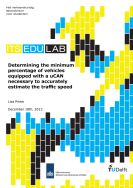In this thesis the use of in-vehicle data, obtained from a uCAN, for the estimation of the traffic speed is investigated. Since vehicles are not equipped with a uCAN yet, the uCAN data is emulated. For this emulation, the traffic simulation model Fosim is used. With the emulated uCAN data, the minimum percentage of vehicles equipped with a uCAN that is necessary to accurately estimate the traffic speed is determined. This minimum percentage is equal to the minimum percentage for which the corresponding estimator for the traffic speed satisfies the accuracy requirement of NDW. The obtained percentage is applied to practical settings to generalize this result from a road section to the highway network of the Netherlands. Since the estimator for the traffic speed, based on data from inductive loop detectors, that is used nowadays does not satisfy the NDW requirement, the necessary minimum percentage of vehicles with a uCAN is also determined for two weaker requirements. The results based on these requirements are also generalized to the Dutch highway network. All three obtained necessary minimum percentages of vehicles with a uCAN for the three requirements also hold in the practical settings.
It can be concluded from the results of this thesis that if in the future 29.5% of the vehicles in the Netherlands is equipped with a uCAN, the estimator for the traffic speed based on the uCAN data from these vehicles satisfies the requirement of NDW. This means that the estimated traffic speed differs at most 5% from the real traffic speed in at least 95% of the minutes. When in the future the mentioned percentage of all vehicles is equipped with a uCAN, the data from inductive loop detectors that is currently used for the estimation of traffic speeds, can be replaced by the data from the vehicles that are equipped with a uCAN. The uCAN data can then be used for traffic management applications related to traffic speed such that traffic management can be improved. Moreover, the estimator for the traffic speed based on this uCAN data will be more accurate than the estimator for the traffic speed based on the data from the detectors. For a requirements weaker than the NDW requirement, the necessary minimum percentage of vehicles with a uCAN is equal to 22.6% or equal to 10.8% for an even weaker requirement. So for a lower accuracy that is still higher than the accuracy of the estimator for the traffic speed that is used nowadays, even less vehicles need to be equipped with a uCAN, what means that then uCAN data can be used in an earlier stage.
